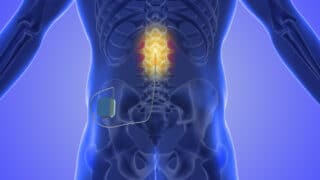
Chesapeake Spine & Pain
110 Hospital Road
Suite #211
Prince Frederick, MD 20678
410-656-2869

More Pain Management & Rehabilitation Articles
The Benefits of Spinal Cord Stimulation in Treating Chronic Pain

Chronic pain, a persistent condition lasting beyond the usual course of acute illness or injury, can significantly impair quality of life and function. For patients whose pain is refractory to conventional treatments, spinal cord stimulation (SCS) offers a promising and effective therapeutic option.
Spinal cord stimulation is a minimally invasive procedure that involves implanting a small device, similar to a pacemaker, which delivers electrical impulses to the spinal cord. These impulses modulate pain signals before they reach the brain, effectively reducing the perception of pain. SCS has been used for decades and is supported by robust clinical evidence for its efficacy in managing various chronic pain conditions, including failed back surgery syndrome (FBSS), complex regional pain syndrome (CRPS), and peripheral neuropathy.
One of the primary benefits of SCS is its ability to provide significant and sustained pain relief. Many patients report a reduction in pain intensity by 50% or more, allowing them to engage in daily activities with greater ease and enjoyment. Unlike oral medications that often come with side effects such as drowsiness, gastrointestinal issues, and potential for dependence, SCS offers pain relief without systemic side effects. This can be particularly advantageous for patients who have experienced adverse reactions or limited effectiveness with pharmacological therapies.
Moreover, SCS is customizable to each patient’s specific pain pattern and intensity. The device can be programmed to deliver different patterns of electrical stimulation, and patients can adjust the settings using a handheld controller to optimize their pain relief throughout the day. This level of personalized pain management can lead to better overall outcomes and improved patient satisfaction.
Another significant advantage of SCS is its reversibility. If a patient does not experience adequate pain relief or encounters any complications, the system can be removed or turned off without permanent alterations to the spine. This makes SCS a flexible and low-risk option compared to more invasive surgical interventions.
In addition to pain relief, SCS has been shown to improve functional outcomes and quality of life. Patients often experience enhanced mobility, better sleep, and reduced reliance on pain medications, leading to an overall improvement in daily functioning and mental well-being. This holistic benefit can be life-changing, enabling patients to regain independence and participate more fully in personal and social activities.
The procedure for implanting the SCS device is typically done on an outpatient basis, involving a trial period where a temporary device is placed to assess its effectiveness. If successful, a permanent device is implanted. This trial phase helps ensure that only patients likely to benefit from the therapy proceed to the permanent implant, enhancing the success rates and patient satisfaction.
In conclusion, spinal cord stimulation offers a powerful and versatile solution for managing chronic pain. With its ability to provide significant pain relief, minimize medication reliance, and improve quality of life, SCS stands out as a cornerstone in the treatment landscape for chronic pain patients, providing hope and renewed possibilities for those struggling with persistent pain.
Other Articles You May Find of Interest...
- Breaking the Chains of Pain: Why Scar and Neural Therapy Is a Game-Changer
- What to Do If You Suspect You Have a Tailbone Injury?
- Understanding TMJ: The Hidden Jaw Factor Behind Many Headaches
- Discover Wellness Naturally with Zelly Pure Health: Boost Vitality and Soothe Aches
- Breaking the Inflammation Cycle: How Your Digestive Health Affects Chronic Pain Management
- Migraine or Something More? When It’s Time to See a Neurologist
- How Chiropractic Care and Physiotherapy Work Together for Pain Relief and Recovery
















